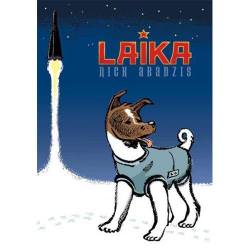Dogs were one of the first creatures to join with human tribes. Their barks and bites kept predators at bay while their wagging tails and happy disposition welcomed those coming home. Some dogs got to do incredible feats in advance of humans, as happened with the first creature to orbit Earth. Laika the graphic novel written and drawn by Nick Abadzis recounts the story of our first astronaut. For it was a dog with this name that the Soviets sent into space in advance of the many humans that followed.
Graphic novels are a great medium for relaying a story. These are so much more than the average comic strips that people read in the Sunday paper. They can have as many pages as a novel, have tens of intricate drawings on a page, and each drawing can relay more emotion and information than most paragraphs written with words. Abadzis uses this medium to great effect in retelling the stories of some special players in the early times of space flight.
The main character in Abadzis’ graphic novel is Laika, our first member of the astronaut ‘tribe’. Using a blend of fiction with fact, the novel follows the dog from its birth on Earth to its death in orbit. But the book is not solely focused on the dog. For example, the author begins with an introductory chapter focusing on Sergei Pavlovich making his way from the gulag back to civilization. But, Abadzis uses the dog as the focal point. However, it’s the people who interact with the dog that give life to the story. The novel displays the emotions and actions of people rather than giving Laika human-like qualities of speech and emotion. With this, the author keeps the story real and relevant.
As such, the novel shows that this dog’s life is less like the pleasures of the rich and famous and more like a harsh slave, outcast and downtrodden. In this manner, Abadzis uses his novel to critique the harsh living conditions in Moscow and the Soviet Union. Yet at the same time he shows the compassion and warmth that spring forth out of horrific events. As an example, the author shows the dog cast out having to fend for itself and people’s generosity comes to its rescue. Yet at the same time, dog catchers want to efficiently clear the streets of the strays. Eventually Laika ends up at the research institute where dogs become test subjects. Here again, people befriend the dog yet there is the expectation that most dogs don’t survive the tests. The author shows this is the case for Laika though he illuminates mixed emotions for the many human characters involved.
The nice thing about this graphic novel is that it tells much but leaves much for the reader to fill in. As with a written novel, the reader can easily put their own emotions into the characters and live their lives. Abadzis uses rich colours, well rounded characters and vibrant backgrounds to lend impact and credence to his story. As well, he’s researched the material, so the factual basis of the events get accurately recounted. Thus, the novel is both pleasurable and informative.
Graphic novels do have great value in telling stories and this novel does so and in doing, will inspire many readers. The story and imagery will intrigue the general reader. The evocative images of Moscow and Tyura-Tam would pique the interest of the burgeoning historian. And of course, the story about Laika, Sergei and the early Soviet space efforts will interest the space enthusiast. For a warm and interesting break from equations and formulae, this book is a wonderful treat.
Laika started us upon our voyage into space. Of course no one would think of writing a biography for this dog. But, Nick Abadzis in his graphic novel Laika recounts the story of this dog and gives a rich, impassioned view of what its life might have been. Dogs have been helping humans for thousands of years. This book shows one more case of their excellent service.
Read more reviews, or purchase a copy online from Amazon.com

